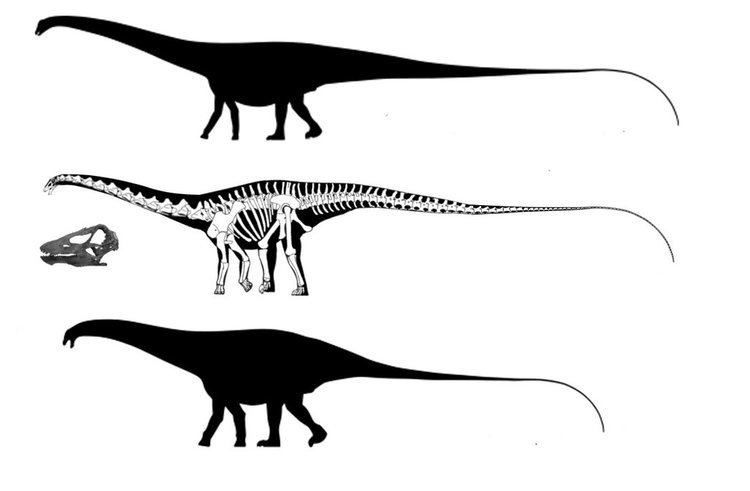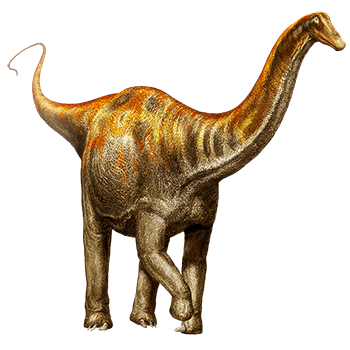Family † Diplodocidae Higher classification Diplodocid | Phylum Chordata Rank Genus | |
 | ||
Similar Dinosaur, Sauropoda, Diplodocid, Dinheirosaurus, Kaatedocus | ||
Galeamopus is a genus of herbivorous diplodocid sauropod dinosaurs. It contains one known species, Galeamopus hayi, known from the Late Jurassic lower Morrison Formation (Kimmeridgian age, about 155 million years ago) of Wyoming, United States. It is known from one of the most well preserved diplodocid fossils, a nearly complete skeleton with associated skull. An additional specimen may represent a distinct species, informally known as G. "shellensis".
Contents

HistoryEdit

Galeamopus was first known from a partial skeleton discovered by fossil hunter William H. Utterback in 1902 near Sheridan, Wyoming, in the Red Fork Powder River Quarry A. In 1906, the skeleton was referred to Diplodocus by William Jacob Holland when he described its braincase. The specimen was classified by Holland as a new species of Diplodocus, Diplodocus hayi, in 1924. The specific name honoured Oliver Perry Hay.

In 2015, it was renamed as the separate genus Galeamopus by Emanuel Tschopp, Octávio Mateus and Roger Benson. The generic name is derived from Latin galeam, the accusative of galea, "helmet", and opus, "need". The combination is intended as a translation of Wil-helm, literally "want helmet", in reference to the first name of both Utterback and Holland. The name is at the same time an allusion to the fact that the brittle braincase of the type specimen is in need of a helmet.

The genoholotype is HMNS 175 (previously CM 662), the original skeleton. It was found in layer of the lower Morrison Formation dating from the Kimmeridgian. This specimen is also the holotype of Galeamopus hayi, the combinatio nova of the type species D. hayi. Several other specimens were referred to the genus Galeamopus but not to Galeamopus hayi. These included specimen AMNH 969, a nearly complete skull discovered in 1903 at the Bone Cabin Quarry by Peter Kaisen; specimen USNM 2673, a partial skull excavated in 1884 by Marshall P. Felch at Garden Park in Colorado; and SMA 0011, a skeleton nicknamed "Max" and found in June 1995 by Ben Pabst at the Howe-Stephens Quarry. SMA 0011 was sufficiently different to consider naming a separate species for it. This specimen (along with AMNH 969) was named G. shellensis in Tschopp's 2013 thesis. However the ICZN does not recognize thesis names as valid, so it will remain informal until the description is published.
DescriptionEdit
The 2015 study established seven distinguishing traits of the genus as such. These were autapomorphies, unique derived characters. On the back of the skull, the paroccipital process is curved in side view. The teeth have paired wear facets. The first neck vertebra, the atlas, has a neural spine with processes pointing to the front and the inside, which are separate from the rear wing of the spine. This rear wing shows a continuous transverse width over most of its length. The neural arch of the atlas has on each side of its base a small triangular spur. The second neck vertebra, the axis, has a neural spine with a knob-shaped bump on the front end of the ridge on its front side. With the middle and rear neck vertebrae, the ridge between the rear joint processes, the postzygapophyses, does not extend beyond the rear edge of the neural arch.
The study also determined six autapomorphies of the type species Galeamopus hayi alone. The part of the parietal bone forming the edge between the rear skull and the skull roof is low, with a height less than that of the foramen magnum. The appending basipterygoid processes at the underside of the braincase strongly diverge at an angle of more than 60°. The ulna of the lower arm is long, with a minimum length equalling 76% of the humerus, upper arm bone, length. The surface on the radius contacting the ulna is limited in size and relatively smooth. The joint surface at the underside of the radius is bevelled relative to the shaft, at an angle of about 15°. The outer edge of the top surface of the shinbone forms a pinched process, behind the cnemial crest at the front.
Autapomorphies for G. "shellensis" include a horizontal canal connecting the preantorbital and the antorbital fenestra laterally on the maxilla, mid and posterior cervical vertebrae with a large foramen connecting the postzygapophyseal centrodiapophyseal fossa and the spinopostzygapophyseal fossa, a robust humerus (unique within Diplodocinae), absence of a shallow, but distinct rugose tubercle at the center of the concave proximal portion of the anterior surface of the humerus (unique within Diplodocinae), and the maximum diameter of the proximal end of the radius divided by its greatest length equals 0.3 or greater (unique within Diplodocinae), a total of five autapomorphies.
ClassificationEdit
Cladogram of the Diplodocidae after Tschopp, Mateus, and Benson (2015).
